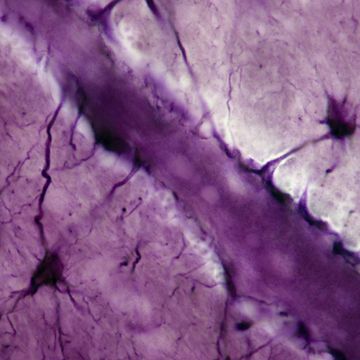Researchers in Moscow have made advances to a device called a memristor, building one that works like a synapse in the human brain. “Memristor” means both memory and resistor, a term coined in 1971 and realized in some form beginning in 2008. The new “second generation” memristor is able to eventually forget data that isn’t accessed often enough, which mimics how human synapses work and the quality of the brain known as plasticity.
The study and design of memristors is usually linked with the subject of neurocomputers, a blanket term for both digital computers that imitate human brains and hypothetical machines made of human neural cells. Data from Star Trek: The Next Generation’s positronic brain, an idea coined by Isaac Asimov, is a fictitious kind of neurocomputer. The idea with advanced memristors is to imitate the way that while a utilized human brain cell stays fully functional in a healthy brain, underused or unused brain cell will deteriorate.
The Russian researchers sought to correct a fundamental flaw in how other second-generation memristors were working: Because of normal mechanical wear and tear, the memristors were breaking down over time. In one sense, this mimics forgetfulness with human age. But that forgetfulness doesn’t permeate the entire human brain, and researchers couldn’t study the idea of modeling brain plasticity without a more robust device to begin with.
To address this, the research team tossed out an existing form of memristor that used current traveling over a microscopic “bridge” and replaced it with a magnetized technology made from an alloy called hafnium oxide. This powdery compound is an insulator used most famously by Intel starting in 2007 as a replacement for silicon dioxide when making gates—micro-circuitry that uses insulation to direct logic within microchips.
Hafnium is a heat-tolerant metallic element used to make welding torches or nuclear rods. In a pure or alloy form it’s a conductor, but when combined with oxygen to make hafnium oxide, it’s a heat-tolerant insulator instead. But in insulator format, it still has metallic properties, including that it holds a kind of magnetic charge that the researchers in Moscow capitalized on when making their memristor.
The ferroelectric—meaning holding a charge similar to how iron holds a charge—hafnium oxide allows the memristor to function. “The implemented ferroelectric second-order memristor exhibits various synaptic functionalities,” the team’s abstract says. The scientists’ design uses the somewhat bumpy and leaky junction between silicon parts and hafnium-based parts as their mechanism for the manufactured “synapse” to forget things. Hafnium’s magnetic qualities make it ideal to gauge “remembering” on an incremental scale over time.
Choosing hafnium has other advantages, too. Because it’s already in demand for existing manufacturing and studied closely by many researchers, hafnium oxide is plentiful and cheaper than if scientists were to begin at square one and develop a brand new material. These researchers have also used access to hafnium oxide as a way to pursue a new mechanism for future neurocomputers of all kinds—not just to directly mimic and study the human memory but to, just as an example, give robots a motivating fear of their own mortality.

Caroline Delbert is a writer, avid reader, and contributing editor at Pop Mech. She's also an enthusiast of just about everything. Her favorite topics include nuclear energy, cosmology, math of everyday things, and the philosophy of it all.












